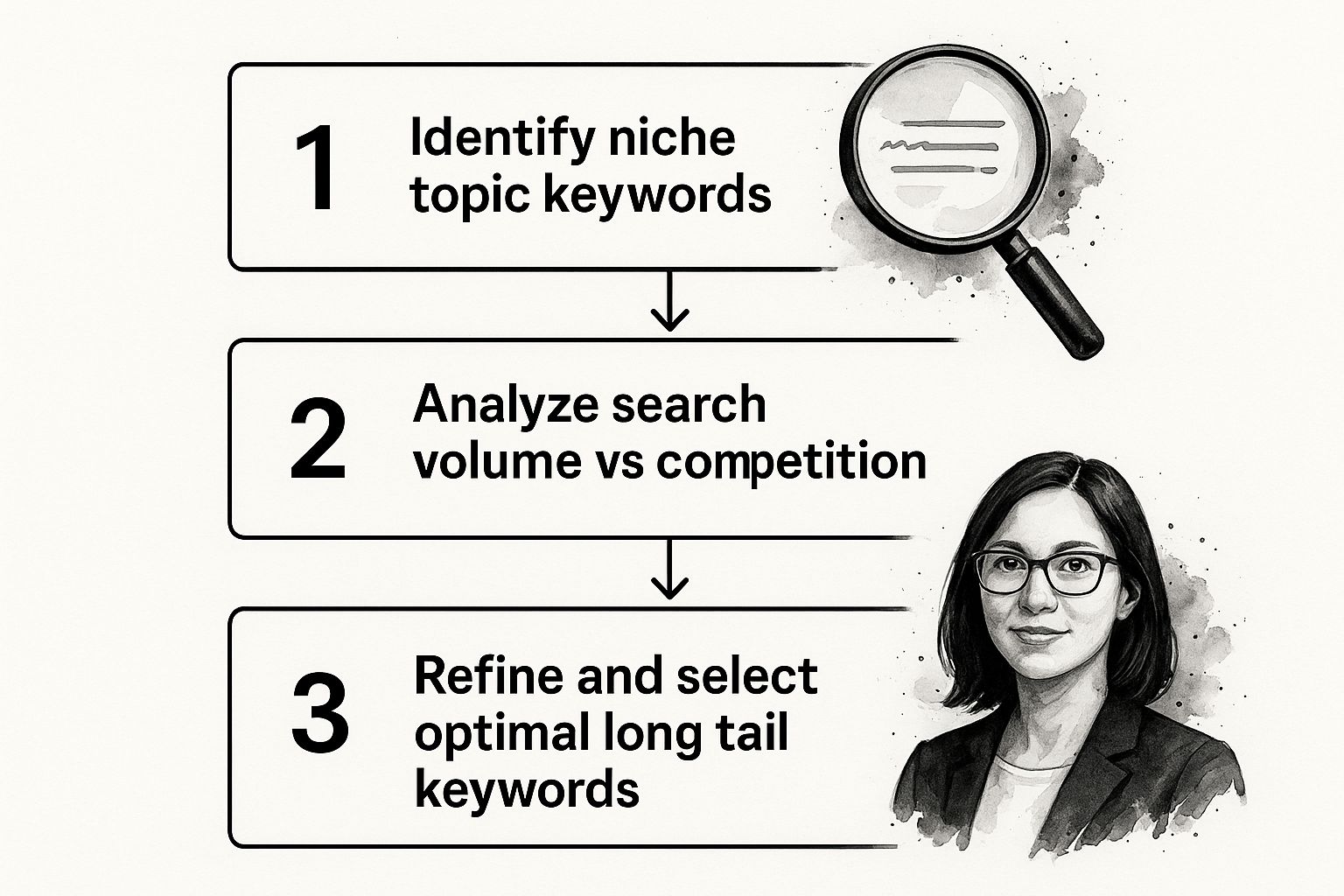When you're first dipping your toes into SEO, it's tempting to chase the big, flashy keywords. You know the ones—short, high-volume terms that feel like they'd open the floodgates of traffic. But going after those is like trying to have a conversation in the middle of a packed concert. It's loud, crowded, and almost impossible to get noticed.
The real magic, especially today, is in the quieter corners of the internet where your ideal customers are searching. This is where long tail keywords come into play.

Think about how people actually use Google now. They don't just type "shoes." They ask questions. They get specific. They search for things like, "best noise-cancelling headphones for open offices" or "waterproof hiking boots for rocky trails." This isn't just a trend; it's a fundamental shift in how we find information.
Getting a handle on long tail keywords isn't just a "nice to have" anymore. It's the core of a smart, modern SEO strategy that actually drives results.
Why Specificity Wins Every Time
Focusing on these longer, more detailed phrases gives you a serious competitive advantage. You're not just throwing content out there and hoping something sticks; you're creating the exact answer someone is looking for.
Here's why that approach works so well:
- You attract the right people. Someone searching for "best trail running shoes for wide feet" is worlds away from someone just typing "running shoes." They're not just browsing; they're actively looking to solve a problem—and probably make a purchase.
- You sidestep the competition. While thousands of huge brands are duking it out for "running shoes," the field narrows dramatically for the long tail version. This gives you a realistic shot at ranking, often much faster than you would for broader terms.
- Your conversion rates go up. This is the big one. Because the user's intent is crystal clear, the traffic you get from these specific queries is far more likely to convert. You're giving them exactly what they asked for, right when they need it.
To put it simply, here's a quick breakdown of how these two keyword types stack up against each other.
Short Tail vs Long Tail Keywords at a Glance
| Attribute | Short Tail Keywords (e.g., 'running shoes') | Long Tail Keywords (e.g., 'best trail running shoes for wide feet') |
|---|---|---|
| Search Volume | High | Low |
| Competition | High | Low |
| Specificity | Broad, general intent | Highly specific, clear intent |
| Conversion Potential | Low | High |
The takeaway here is pretty clear. While short tail keywords look great on paper because of their high search volume, long tail keywords are where the real, tangible business results often come from.
The rise of voice search and digital assistants has only poured fuel on this fire. An incredible 91.8% of all search queries are now considered long tail. People are talking to their devices, and they're using natural, conversational language to do it.
To really make the most of this, your keyword research needs to be paired with proven strategies to increase organic website traffic. For even more ideas on how to grow your audience, the RebelGrowth blog (https://rebelgrowth.com/blog) is a great resource to check out.
Now, let's get into the good stuff: the practical, step-by-step techniques you can start using today to unearth these powerful phrases for your own site.
Finding Keyword Gems in Forums and Communities
Keyword tools are great, but they have a blind spot: they only show you what people are already searching for in high volumes. The real gold is often hiding where your audience hangs out and talks shop—in niche forums, Reddit threads, and online communities.
This is where you can dig up the raw, unfiltered language your customers use every single day. People aren't trying to optimize for search engines here. They're just asking for help, venting their frustrations, or looking for a specific recommendation. That natural language is a treasure trove of high-intent, long-tail keywords that most of your competitors are completely missing.
Tapping into Niche Conversations
The trick is to stop thinking like a marketer and start thinking like a customer. Before you even open a keyword tool, figure out where your ideal audience gathers online. This could be a specific subreddit, a niche industry forum, or a Q&A site like Quora.
Once you’ve found their digital water cooler, you can use simple search tricks to unearth keyword opportunities.
Let’s say you sell home gym equipment. You could pop over to a subreddit like r/homegym and start searching for phrases that signal a user has a problem they need to solve.
"how do I""recommendation for""problem with""alternative to"
This simple method immediately surfaces real-world questions that are perfect seeds for super-targeted content. You’ll find gems like "recommendation for a quiet treadmill for an apartment" or "how do I build a budget squat rack." Boom. Those are perfect long-tail keywords right there.
Just look at this example from Reddit. It's a perfect illustration of how users ask incredibly specific, problem-focused questions—the kind that makes for amazing content.

This is how you get beyond generic keywords and find the exact phrasing people use when they're getting close to pulling out their credit card.
Organizing Your Findings for Content Clusters
As you start pulling these phrases out, don't just dump them into a messy spreadsheet. Start organizing them by theme. You might notice a pattern of questions around budget-friendly options, space-saving equipment, or beginner workout routines.
Each one of those themes can become a pillar page in your content strategy. The specific long-tail keywords you uncovered then become the supporting articles that link up to it.
This approach does more than just give you a list of keywords; it hands you a map of the entire customer journey. You get to see their initial questions, their follow-up concerns, and the criteria they use to make a final decision, all in one place.
If you really want to level up, understanding how these communities work on a deeper level can unlock even richer insights. Learning some strategies for building online communities can give you a better feel for user dynamics. By becoming an active listener, you can build an entire content plan that directly solves the documented needs of your audience, making sure every single piece you publish truly connects.
Using Google's Features for Free Keyword Ideas
Some of the best tools for digging up long-tail keywords won’t cost you a dime. In fact, they’re hiding in plain sight, built right into the Google search results you probably use every day. These features are a direct line into what real people are thinking, showing you exactly how they search for things online.
By tapping into these free resources, you can uncover dozens of high-intent keywords without ever leaving your browser. It’s a bit of a manual approach, but it's fantastic for really understanding the little quirks and patterns of search behavior in your niche.
Google Autocomplete is Your First Stop
That search bar isn't just for searching; it's a powerful research tool. As you start typing, Google Autocomplete kicks in, trying to predict what you're looking for based on what's popular right now. This is an absolute goldmine for long-tail ideas because it’s literally showing you what actual people are typing into that box.
Don't just plug in a head term and call it a day. Get creative. Instead of just "container gardening," try typing "how to start container gardening for" and just... wait. Google will hand you a list of valuable long-tail phrases that people are already searching for.
For instance, look at the instant suggestions that pop up for this simple query.

Every single one of those suggestions represents a specific user's need—and a potential piece of content you could be creating.
Mine the "People Also Ask" Boxes
Another incredibly useful feature is the "People Also Ask" (PAA) box that shows up in a ton of search results. These are direct questions related to what you just searched, giving you a peek into a user's research journey and their follow-up questions.
The PAA section isn't just a list of keywords; it’s a content outline waiting to be written. Each question represents a subheading or section in a comprehensive article, allowing you to address multiple user needs in a single post.
The best part? When you click on one question, the box expands to give you a quick answer and often triggers even more related questions to appear. You can spend a few minutes clicking through these and map out an entire topic cluster, making sure your content is ridiculously thorough.
Scroll Down for Related Searches
Last but not least, always make your way to the very bottom of the search results page. That "Related Searches" section is a fantastic way to discover new content angles or related topics you hadn't even thought of.
It’s like lateral thinking for SEO. If your original search was for "best soil for tomatoes in pots," you might see related searches like:
- Homemade potting mix for tomatoes
- Fertilizer for container tomatoes
- How often to water tomatoes in pots
This little list helps you build out a complete content hub that covers a topic from every possible angle. For any business trying to grow its online presence, pairing these free Google methods with a solid listing in the right places can be a game-changer. You can browse a curated directory of tools and services at RebelGrowth (https://rebelgrowth.com/directory) to find other resources to boost your SEO efforts.
While digging around manually gives you some great gut-check insights, you need a repeatable system to really scale up your long-tail keyword research. This is where SEO tools are an absolute game-changer, turning a painfully tedious task into an efficient way to find opportunities.
Honestly, it’s less about the specific tool you use and more about the workflow you build around it.
The core idea is pretty simple: you start with a broad "seed" keyword and then use a series of filters to methodically drill down to those low-competition, high-intent phrases. This whole process is designed to get you past the obvious, high-traffic terms and into the specific questions your actual audience is asking.
Let's say your seed keyword is something big like "project management software." If you just plug that into a tool like Ahrefs or Semrush, you'll get back thousands of related keywords, and most of them will be way too competitive to even think about. The real magic happens when you start applying some strategic filters.
Creating a Repeatable Keyword Workflow
To find keywords you can actually do something with, you need to tell your SEO tool exactly what you're looking for. Think of it like giving it precise instructions to find the needles in the keyword haystack. Your mission is to filter out all the high-competition noise and isolate those long-tail gems.
Here are a few filter combinations I find myself using all the time:
- Filter by Word Count: I'll set a minimum word count of 4 or more. This simple step immediately gets rid of most of the broad head terms and shifts the focus to longer, more specific phrases.
- Filter by Keyword Difficulty (KD): Next, I'll set a maximum KD of 20 or less. This is huge for finding keywords that newer or smaller sites actually have a shot at ranking for without needing a monster backlink profile.
- Filter for Questions: I also love using modifiers like "how," "what," "where," "why," or "best." This is a direct line to finding people who are problem-aware and actively looking for solutions, which is a fantastic indicator of strong search intent.
Stacking these filters together is where you get a truly powerful system. For that "project management software" example, a filter stack of Word Count > 4, KD < 20, and including the word "for" might spit out something like "best project management software for small creative teams." Now that's a highly specific, low-competition keyword you can build a killer piece of targeted content around.
This infographic gives a good overview of the general process, from figuring out your niche to honing your final keyword list.

The visual really drives home that good research isn't just about finding random keywords. It’s a strategic process of identifying, analyzing, and ultimately choosing the terms that give you the biggest potential impact with the lowest barrier to entry.
Beyond the Basics with Advanced Modifiers
Once you've got the hang of those basic filters, you can start getting even more granular. Think about other types of modifiers that signal different kinds of user intent. Are you trying to find people who are ready to pull out their credit card, or are they just kicking the tires and starting their research?
Here are some more advanced modifiers I like to play with:
- Transactional Modifiers: Words like “alternative,” “review,” “vs,” and “comparison” are pure gold for finding commercial intent. Someone searching for “monday.com alternative for nonprofits” is pretty far down the funnel and is actively weighing their options.
- Informational Modifiers: On the other hand, phrases like “template,” “example,” “checklist,” and “guide” suggest the user is looking for educational resources. This is perfect for top-of-funnel content that helps you build trust and establish your authority.
Of course, when the sheer volume of this systematic keyword discovery gets overwhelming, you might think about getting some professional help. You can learn more about hiring an SEO specialist to manage these opportunities effectively. Building and refining this system definitely takes some time upfront, but it’s a scalable way to consistently find those SEO opportunities that bring in qualified traffic.
How to Validate and Prioritize Your Keyword List
Finding long tail keywords is the easy part. Knowing which ones are actually worth your time? That’s where the real strategy kicks in. A sprawling spreadsheet of phrases is just noise until you have a system for validating them.
This process turns your raw data into an actionable content roadmap. It’s all about focusing on what truly matters: relevance, search intent, and business value. Not every keyword that looks good on paper will actually move the needle for you. This framework helps you cut through the clutter and zero in on opportunities that drive real results.
Analyze Audience Relevance First
Before you even glance at search volume or difficulty scores, ask yourself one simple question: "Does this keyword perfectly align with a problem my audience has that I can solve?"
If the answer isn't a confident "yes," the keyword is probably a dud, no matter how low its competition is.
For example, if you sell high-end coffee beans, the keyword "how to make dalgona coffee at home" is a perfect fit. But "best cheap instant coffee packets" is way off base, even if it has decent search volume. Chasing irrelevant traffic just leads to high bounce rates and low engagement, which tells Google your content isn't the right match for that query.
Decode Search Intent with SERP Analysis
Next up, you have to figure out what Google wants to rank for your target keyword. This is non-negotiable. The quickest way to do this is to roll up your sleeves and manually analyze the Search Engine Results Page (SERP).
Just type your keyword into Google and see what shows up on page one.
- Content Format: Are the top results blog posts, product pages, videos, or forum discussions? If the entire first page is YouTube videos, trying to rank a blog post is an uphill battle. You have to match the dominant content format.
- Content Angle: What kind of headlines and titles are ranking? Are they "How-To" guides, listicles ("7 Best..."), case studies, or comparison articles? This tells you exactly what angle users find most helpful for that specific query.
Don't fight the SERP. If Google is rewarding a specific type of content, that's your cue to create the best version of that format. Trying to rank a product page for an informational query is a recipe for failure.
This hands-on analysis gives you a qualitative understanding that no keyword tool can provide. It makes sure the content you create meets user expectations right from the start.
Prioritize Based on Business Value
Finally, it’s time to connect your keywords to tangible business outcomes. This is where you separate the "nice-to-have" keywords from the ones that actually drive revenue. Look for phrases with clear commercial intent.
Modifiers like “best,” “review,” “alternative,” or “vs” are strong signals that the user is close to making a purchase decision. These are almost always high-priority targets. For instance, someone searching for “best project management tool for remote teams” is much closer to buying than someone just searching “what is project management.”
To help you get objective, you can use a simple scoring framework to rank your keywords. This removes the guesswork and ensures you're working on the highest-impact terms first.
Keyword Prioritization Framework
| Keyword | Relevance (1-5) | Intent Clarity (1-5) | Commercial Value (1-5) | Total Score |
|---|---|---|---|---|
| best project management tool for remote teams | 5 | 5 | 5 | 15 |
| asana vs monday for startups | 5 | 5 | 4 | 14 |
| how to use project management software | 4 | 4 | 2 | 10 |
| what is project management | 3 | 3 | 1 | 7 |
By assigning a score to each factor, you get a clear, data-driven list of priorities. The keywords with the highest total scores should be at the top of your content calendar.
Creating content for these high-value, transactional keywords often means building out detailed comparison pages or in-depth reviews. These pages are invaluable assets, serving a similar function to well-designed landing pages because they are built to guide a user toward a specific action.
When you prioritize keywords with clear business value, your long tail research becomes a direct driver of growth, not just traffic.
Got Questions About Long-Tail Keywords?
As you start digging into long-tail keyword research, a few questions always seem to surface. Let's tackle those common uncertainties right now so you can move forward with confidence. Honestly, getting these fundamentals down can make or break your entire strategy.
Is Low Search Volume Really Okay?
One of the first things people ask is about volume. Is it actually worth targeting a keyword that only gets 10 or 20 searches a month?
The answer is a definite yes. While a single long-tail keyword won't open the traffic floodgates, a whole collection of them absolutely will.
Remember, these low-volume phrases often have sky-high conversion rates because the user's intent is so incredibly specific. I'd rather have a handful of highly motivated visitors from a perfectly targeted long-tail term than hundreds of casual browsers from a broad, generic one.
How Many Long-Tail Keywords Should I Weave Into an Article?
There isn't a single magic number here, but a solid rule of thumb is to focus on one main long-tail keyword and then back it up with three to five closely related variations. This is the sweet spot that avoids "keyword stuffing" and keeps your writing sounding natural.
The goal is to build a comprehensive resource that nails the user's primary question and even anticipates what they'll ask next. Your main long-tail keyword should be the North Star for your article's structure, while the secondary ones can be woven into subheadings and the body copy.
Here’s a quick example:
- Primary Keyword: "best trail running shoes for wide feet"
- Secondary Keywords: "lightweight trail runners for wide feet," "most comfortable hiking shoes for wide feet," "wide toe box trail running shoes review"
This approach helps you start ranking for a whole cluster of related terms, seriously broadening your article's reach.
What's the Difference Between Long-Tail and Niche Keywords?
This is a super common point of confusion. They're similar, but they aren't interchangeable. A niche keyword defines a specific market segment, whereas a long-tail keyword is a very specific search query within that niche.
Think of it like this: "Vegan baking" is a niche. A long-tail keyword inside that niche would be something like, "how to make a vegan chocolate cake without oil." The niche is the broad playground; the long-tail is the specific problem someone is trying to solve.
Ultimately, your long-tail keyword research is what helps you uncover the exact language and pain points people are using within your bigger niche.
Another question that comes up is whether long-tails are even still relevant. With search algorithms getting smarter, some people wonder if just focusing on broad topics is the better play.
The truth is, long-tail keywords are more important than ever. They mirror the natural, conversational way people search—especially with the explosion of voice assistants. An estimated 92% of all keywords are long-tail, which means they represent the overwhelming majority of all search queries. Ignoring them means you're ignoring how most of your audience is actually trying to find you.
Ready to put these strategies into action and streamline your entire content creation process? rebelgrowth offers a suite of AI-powered tools designed to help you discover high-impact keywords, generate optimized blog posts, and manage your social media presence effortlessly. Check out our solutions at https://rebelgrowth.com and start growing your traffic today.
